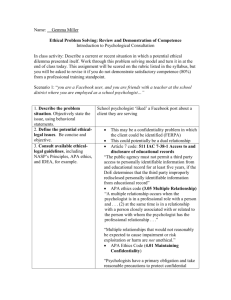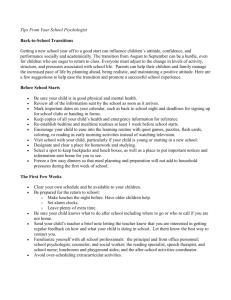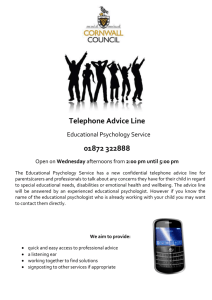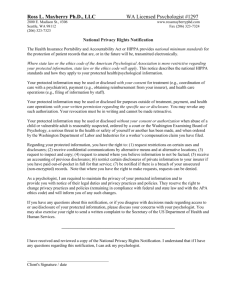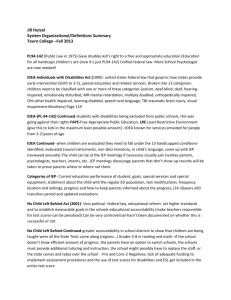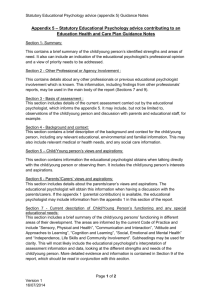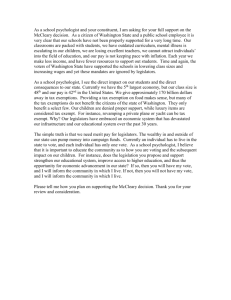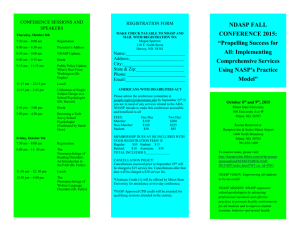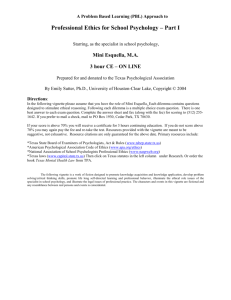Artifact #2- Spring 2014
advertisement
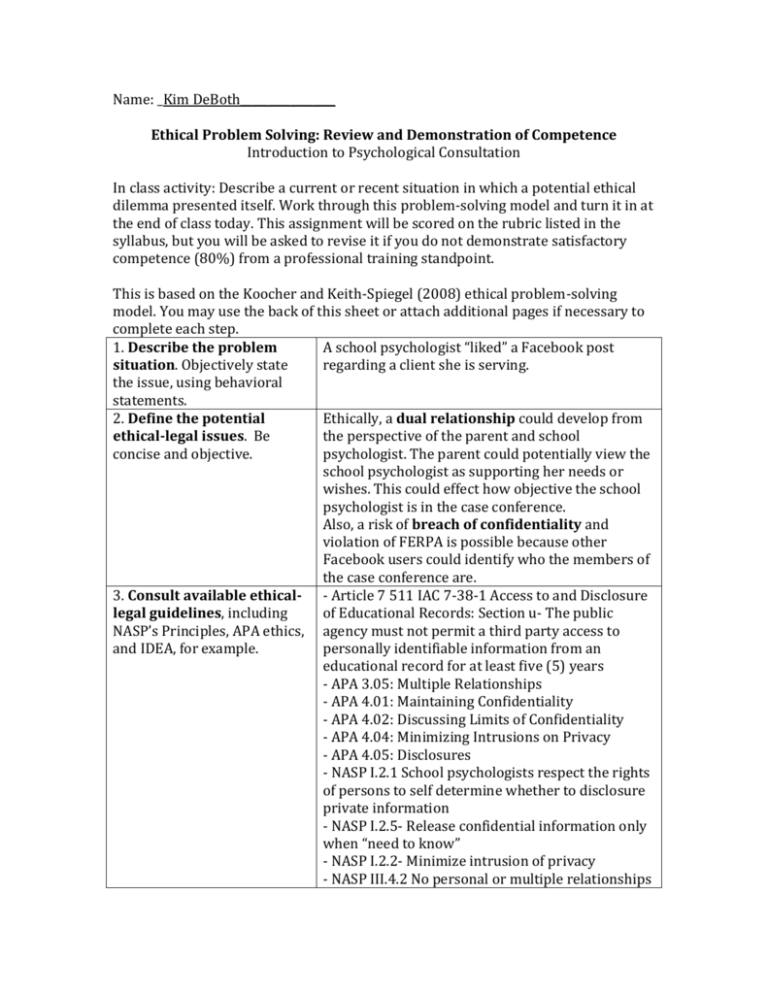
Name: _Kim DeBoth_________________ Ethical Problem Solving: Review and Demonstration of Competence Introduction to Psychological Consultation In class activity: Describe a current or recent situation in which a potential ethical dilemma presented itself. Work through this problem-solving model and turn it in at the end of class today. This assignment will be scored on the rubric listed in the syllabus, but you will be asked to revise it if you do not demonstrate satisfactory competence (80%) from a professional training standpoint. This is based on the Koocher and Keith-Spiegel (2008) ethical problem-solving model. You may use the back of this sheet or attach additional pages if necessary to complete each step. 1. Describe the problem A school psychologist “liked” a Facebook post situation. Objectively state regarding a client she is serving. the issue, using behavioral statements. 2. Define the potential Ethically, a dual relationship could develop from ethical-legal issues. Be the perspective of the parent and school concise and objective. psychologist. The parent could potentially view the school psychologist as supporting her needs or wishes. This could effect how objective the school psychologist is in the case conference. Also, a risk of breach of confidentiality and violation of FERPA is possible because other Facebook users could identify who the members of the case conference are. 3. Consult available ethical- - Article 7 511 IAC 7-38-1 Access to and Disclosure legal guidelines, including of Educational Records: Section u- The public NASP’s Principles, APA ethics, agency must not permit a third party access to and IDEA, for example. personally identifiable information from an educational record for at least five (5) years - APA 3.05: Multiple Relationships - APA 4.01: Maintaining Confidentiality - APA 4.02: Discussing Limits of Confidentiality - APA 4.04: Minimizing Intrusions on Privacy - APA 4.05: Disclosures - NASP I.2.1 School psychologists respect the rights of persons to self determine whether to disclosure private information - NASP I.2.5- Release confidential information only when “need to know” - NASP I.2.2- Minimize intrusion of privacy - NASP III.4.2 No personal or multiple relationships 4. Consult with supervisors and colleagues. Brainstorm possible options. 5. Evaluate rights, responsibilities, and welfare of all affected parties. Remember to advocate for the child client, and do no harm, in particular. 6. Consider alternative solutions and the consequences of each decision. Pros and Cons of each alternative. that minimize professional effectiveness - NASP III.4.4 Cautious of other multiple relationships that minimize professional judgment - FERPA 34 CFR § 99.31 No disclosure of educational records without consent 1. To address the possible dual relationship, a meeting could be recommended with the teacher and parent. This meeting could also address posting confidential information on facebook. 2. Unfriend teacher and unlike post 3. Discuss general Article 7 guidelines with the teacher 4. If it is regarding the student, discuss the post in the case conference 5. Do nothing 6. Delete Facebook account 7. Professional development for school regarding social media The student is the primary responsibility of the school psychologist, followed by the parent. The teacher, special education director and school psychologist are also key members. The student’s right to a confidential educational record is imperative. The school psychologist also has a strong responsibility to follow her supervisor’s requests. The school psychologist also needs to respect the teacher’s privacy and autonomy on social media. - By ‘unfriending’ the teacher, the school psychologist decreases the risk for future problems for the child and parent. It could also harm the teacher because of risk of emotional harm. - By ‘unliking’ the post could prevent future problems for dual relationships. - Having a conversation with the teacher regarding Article 7 and social media could protect the client’s privacy (and future clients’ privacy) - Discussing the post in the case conference, could clear up any confusion regarding the dual relationship with all members of the committee. - By doing nothing, the school psychologist would not breach any further confidential information - By doing professional development, it could decrease liability for future risks of confidential information. 7. Make a decision and take responsibility for it. Which solution is best and how will you know if it worked? The best solution appears to be to discuss the dual relationship that potentially formed by ‘liking’ the post in the case conference. This solution will provide clarification to the parent regarding the school psychologist’s motivation for liking the post as well as re-establishing the professional relationship needed for the case conference. During this meeting, it is important to be clear, professional and not overly explanative. Also, the ‘like’ of the facebook post should be removed to avoid further ethical dilemmas. If this method works the parent and school psychologist should leave the meeting with a clear understanding of everyone’s roles as well as standards of how to proceed on social media. Any further concerns that the parent has should be addressed as well.
